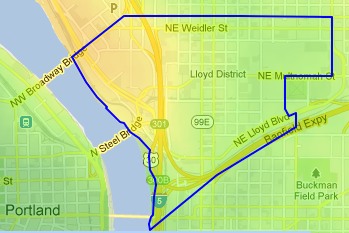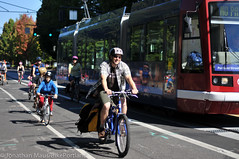Bike Score (the same folks that created the more widely-known Walk Score) have ranked Portland as the #1 “most bikeable” large city in the United States. In their rankings, which were released today to coincide with National Bike to Work Week, Portland squeaked into first place, just 0.3 points ahead of San Francisco. Denver, Philadelphia, and Boston rounded out the top five spots.
When these same rankings came out last year, Portland was #2 behind Minneapolis, but this year cities above 500,000 people competed against each other while smaller cities were put on a separate list.
And for the first time ever, the Bike Score team also scored individual neighborhoods. In Portland, the Lloyd neighborhood was found to be the most bikeable, receiving a 98.2 out of 100 points. The Bike Score methodology ranks locations based on four equally weighted components: Bike lanes, hills, destinations and road connectivity, bike commuting mode share.

ike Score found to be the most bikeable in Portland.
We got an early peek at the neighborhood rankings and I’ve pulled out the top 20 Portland neighborhoods:
- Lloyd – 98.2 (pop. 1,354)
- Old Town/Chinatown – 97.9 (pop. 3,656)
- Pearl District – 96.8 (pop. 6,053)
- Hollywood – 95.3 (pop. 1,339)
- Sullivan’s Gulch – 94.9 (pop. 3,193)
- Buckman – 94.7 (pop. 8,472)
- Eliot – 92.8 (pop. 3,573)
- Arbor Lodge – 92.8 (pop. 6,126)
- Hosford-Abernethy – 92.0 (pop. 7,371)
- Downtown – 91.9 (pop. 12,675)
- Boise – 90.6 (pop. 3,269)
- Kerns – 90.1 (pop. 5,301)
- Humboldt – 89.9 (pop. 5,156)
- Laurelhurst – 89.6 (pop. 4,721)
- Richmond – 89.5 (pop. 11,659)
- Irvington – 88.6 (pop. 6,655)
- Kenton – 88.1 (pop. 7,228)
- Sunnyside – 88.0 (pop. 7,233)
- Overlook – 86.7 (pop. 6,114)
- Piedmont – 86.4 (pop. 7,018)
These Portland neighborhood results are surprising. Lloyd is not the first place we think of when they hear the phrase “bike-friendly.” In fact, “avoid the Lloyd” is something of a rallying cry among locals frustrated with that area’s bikeway connectivity. However, in recent years additions to the bike network in the Lloyd area might be changing that. In the past few years we’ve seen the new, wide (and in some places protected) bike lane on NE 7th adjacent to the new streetcar line, the improvements on and around the NE 12th Avenue overcrossing, and of course the protected bike lane on NE Multnomah.
That being said, it’s impossible for any ranking system like this to include subjective information about riding in a particular area. Numbers alone cannot quantify how a place feels while riding through nor can they measure stress levels. It’s also important to note that Portland’s network of bike boulevards/neighborhood greenways don’t impact the rankings because they are not captures as “bike lanes” or bike infrastructure.
Bike Score also announced today that their data is available in 100 U.S. cities. Bike Score uses their data primarily as a way to encourage and inform the real estate industry about how biking and walking trends impact housing values. Learn more at WalkScore.com.


